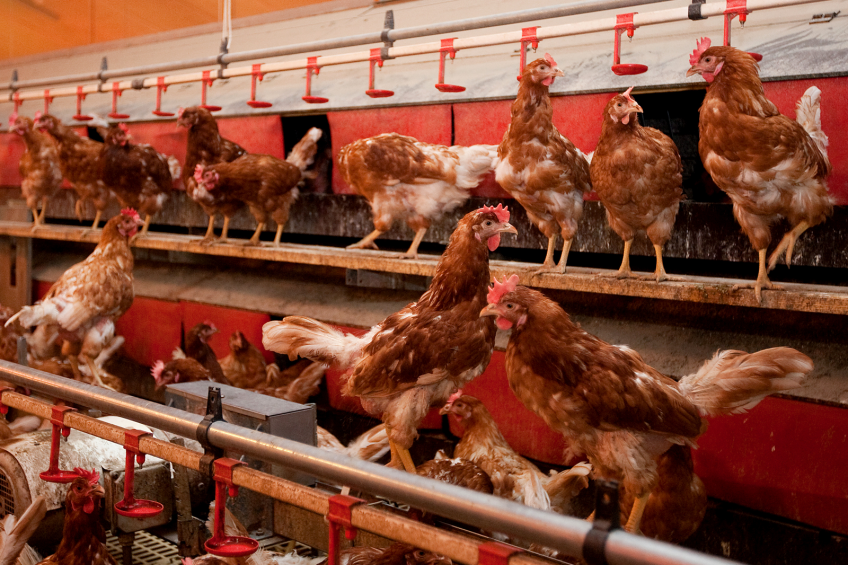Maintaining production in mature layers

There is considerable economic interest to maintain production in mature layers. This has traditionally been accomplished by induced moulting, a practice not free from welfare concerns. Feeding a probiotic is a tool to maintain production in mature layers, without moulting.
To be economically successful mature layers need high performance parameters with a laying percentage of 80% or higher, a feed conversion rate lower than <2.15 and a cumulative mortality below 5%. one possibility is to improve the nutritional status of the layers. probiotics are of interest here as they can help support an efficient gastrointestinal function which is quite important in older layers. possible modes of action of probiotics relevant to layers are: inhibition of pathogen growth in the gastrointestinal tract, increased mucosal villus heights and deeper crypts in the ileum, increases in digestive enzyme activity and increased antibody (iga and igg) formation. >
The ability of the probiotic Clostat to maintain productivity in mature layers was studied in a comprehensive trial in the Department of Poultry Science at the Olsztyn University of Warmia and Mazury, Poland. Clostat is a probiotic based on Bacillus subtilis which received an authorisation for use in laying hens and breeders from the European Commission (EC) in 2015. This ruling of the EC completed the approval process for usage in all poultry species (layers, breeders, broilers, turkeys, and minor species) and in piglets. The EC recognised that this probiotic could accentuate growth and is safe for the birds, human health and the environment.
Put to the test
Lohmann Brown laying hens from a commercial flock at 52 weeks of age were fed mash diets based on wheat, triticale, corn and soybean meal over 20 weeks, until 72 weeks of age (Table 1). The calculated and analysed feed compositions were quite comparable (Table 2). During the first four weeks all hens received the same commercial diet then for the next 16 weeks (57 to 72) treatments were applied. There were two treatments: Control and Clostat at 500 g/ton of feed, which supplied 7.5 X 108 cfu/kg feed. The layers at 52 weeks of age had an average weight of 1975 g. The layers were housed two per cage and four cages constituted one replicate. There were nine replicates per treatment with a total of 72 layers per treatment.
The researchers at Olsztyn University measured six main performance parameters:
Results
Birds in both treatment groups performed well and exhibited good health. There were no mortalities in the control group and only two (0.03%) in the probiotic group. There was very little change in body weight over the trial, an increase of 32 g for the control birds and 38 g in the Clostat treatment group. Egg production was improved with probiotic treatment, particularly in weeks 9-16 (Table 3). Over the whole experimental period of 16 weeks the improvement in laying percentage was 3.9%. The increase in egg production was accompanied by an increase in egg mass (g egg/hen/day) as shown in Table 4. Feed intake was acceptably low and remained quite constant throughout the trial and with no effect of treatment (Table 5). However, the improved egg production with Clostat and a constant feed intake indicates that the FCR (g feed/g egg) would also be lower with the probiotic treatment. There was a consistent tendency in each period for a reduced FCR (Table 6). The data from FCR and egg production indicated a very useful economic advantage from using the probiotic with an ROI of 8.2.
Several parameters of egg quality were also measured in the trial. A summary of the results is shown in Table 7. Clostat was able to increase the number of eggs produced which is an important economic characteristic. The various egg quality parameters were not greatly different between treatments but the probiotic group showed a consistent higher trend. A more detailed analysis of the data provides some information on the improved nutrient utilisation by the addition of the probiotic to the feed (Table 8). There was substantially more total egg production in the probiotic group. Furthermore, this was associated with higher levels of shell, yolk and albumen synthesis. These data strongly indicate that Clostat improves general nutrient uptake and utilisation by the layer, most probably due to better gastrointestinal health.
Useful economic advantage
The Clostat probiotic was able to show consistent improvements in the various performance characteristics of mature layers and demonstrated a useful economic advantage with an ROI of 8.2. These results are in agreement with several previous reports where probiotics have given benefits in layers.
Layers at 70 weeks of age receiving a probiotic treatment exhibited greater mean egg weights and had reduced feed costs. Research shows that supplementation of a probiotic during the late laying period increased egg production, reduced mortality, and improved feed conversion efficiency. A possible benefit of probiotics in layers is from the maintenance of normal gut morphology and mucosal immunity. This is the most likely the explanation for the increased synthesis of egg mass and all its components in the probiotic group.
The probiotic, Clostat is a valuable component in mature layer feeds as it helps the layer get better value from the feed intake. It will help to maintain health and give economically significant improvement in production. Furthermore, the product is a probiotic fully registered in the EU and is safe for the birds, human health and the environment.
References available upon request.













